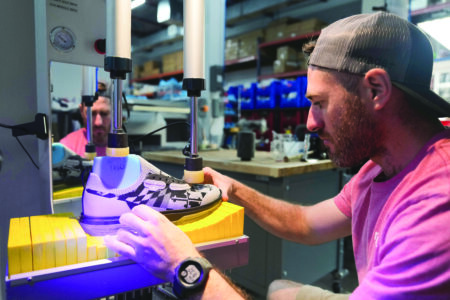The Midfulness Mindset
Gwinn area students learning better ways to behave

K.I. SAWYER — There can be mayhem in a classroom, or there can be mindfulness.
Most schools would choose the latter.
Craig Kitchen of Marquette, a therapist for 32 years, comes to K.I. Sawyer Elementary School twice a week to teach mindfulness to students.
His wife, Judy, used to teach at Sawyer where special efforts were to be made about three years ago to help students with difficult lives.
Kitchen had asked her what the school knew about mindfulness.
“Mindfulness is one of the main treatment modalities for people who have been traumatized,” he said.
Kitchen then worked with eight to 10 students for a few weeks.
Last year, he volunteered one day a week to teach students about meditation practices and the values of mindfulness, such as patience, generosity, acceptance and being non-judgmental.
This year, Kitchen was asked to come back two days a week to work with third-, fourth- and fifth-graders, being funded by an “at risk” federal grant.
Sometimes there’s one-on-one interaction with students. For instance, during the early afternoon of March 12, he played the card game War with a boy.
When an adult in the room mentioned War had been one of the first games she learned as a child, the boy immediately asked, “What was the first game?”
That response showed curiosity and an interest in the person.
“For some of the kids, it’s a huge difference, and for the kids that have trouble focusing, it teaches them how to focus,” Kitchen said. “In the classrooms, what I do is I work a lot on acceptance of other people, non-judgment, and doing that in terms of the way they treat each other.”
This is when bullying — or rather not bullying — comes into play.
“When they learn to be respectful and kind and respectful of each other, that eliminates bullying, and so that’s how I relate the mindfulness to the everyday lives of the students,” Kitchen said. “When they’re aware of how they feel when they’re being picked on by somebody, they’re more likely to think, ‘Wait a minute. Do I want to do that to somebody else?'”
Connie Sather, who teaches in the school’s Flex Room for kids needing a “timeout,” said parents have given Kitchen permission to work with their children’s behavioral issues individually.
When Kitchen works with entire grades, he goes into the classrooms, while with individuals and small groups, he uses the Flex Room or a separate room, she said.
“I think that we’ve noticed a big difference,” Sather said.
And it’s been in a good way.
Kitchen said one teacher noticed such a change she began using the mindfulness method at home.
One grade in particular has been affected.
“The two fifth-grades especially are like magic, going in to work with them, because they talk about a variety of different things that they’ll bring up on their own, and we talk about it in terms of this awareness in the present moment,” Kitchen said.
As with many youngsters in that age bracket, or even high schoolers, cliques can be a problem.
That is addressed through the mindfulness curriculum.
“We talk about the difference between the power of the people in the cliques versus the power of people that are just friends in those groups,” Kitchen said, “and the hurt that comes out of that power that’s in cliques where there’s somebody actively saying, ‘I’ll be your friend today as long as you’re not friends with them.'”
A lot of Kitchen’s work has focused on self-control, managing emotions through breathing in and out, and not being quick to react, Sather said.
“That’s been a big deal,” Sather said.
Continuity is important too.
Sather noted Kitchen also this year has been going to Gilbert Elementary School and Gwinn Middle School, one day a week for each school, since many fifth-graders who relied on him during the 2017-18 school year now attend the middle school.
Fifth-grade teacher Connie Clement is pleased at how the mindfulness mindset is working out at Sawyer.
It’s an improvement over years past, she said, because students are pausing more before taking action.
“You can see them thinking,” Clement said. “When they do things, some of them stop and think, ‘OK, what should I be doing? Is this the right decision?'”
As with many learning methods, some students will integrate them more than others.
“The ones who buy into it, you can just see it in them,” Clement said. “They just love that breathing in and breathing out and just trying to do things we never learned as kids.”





